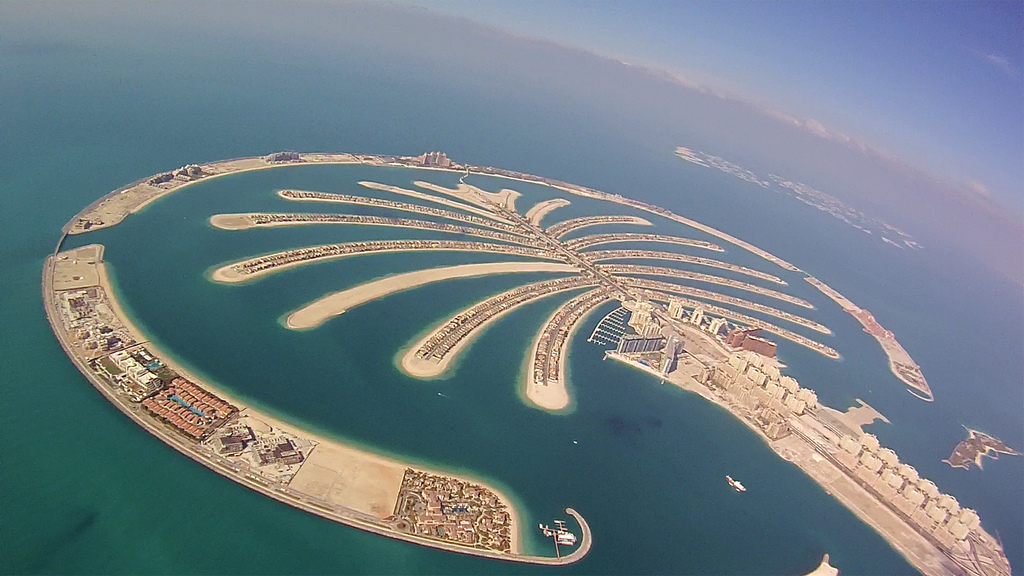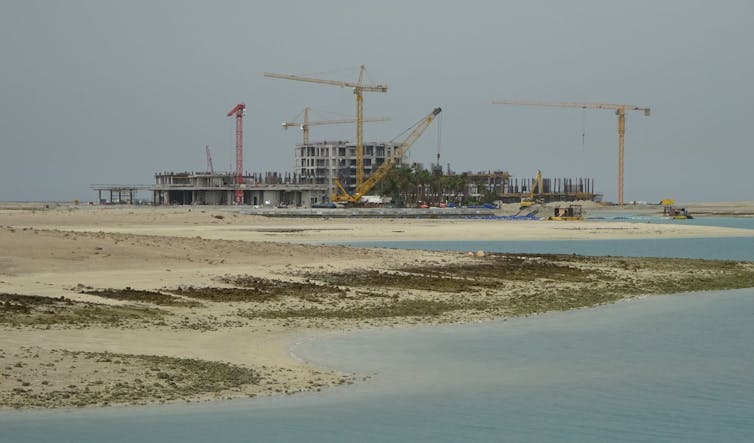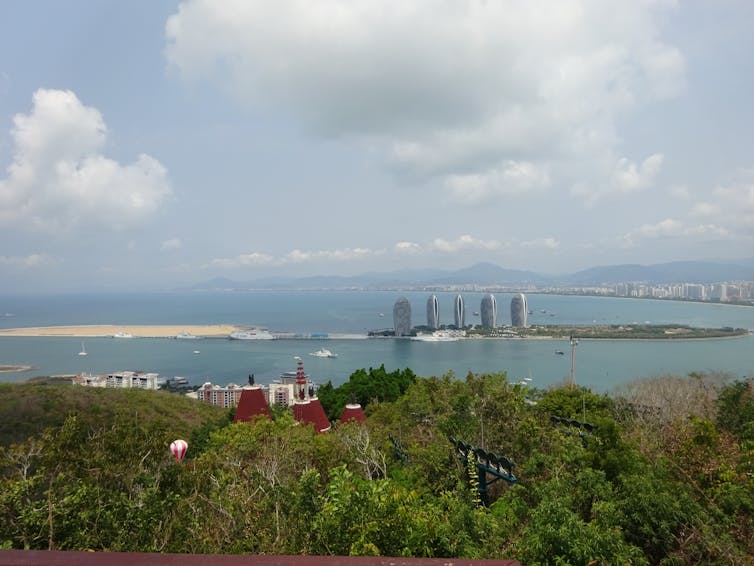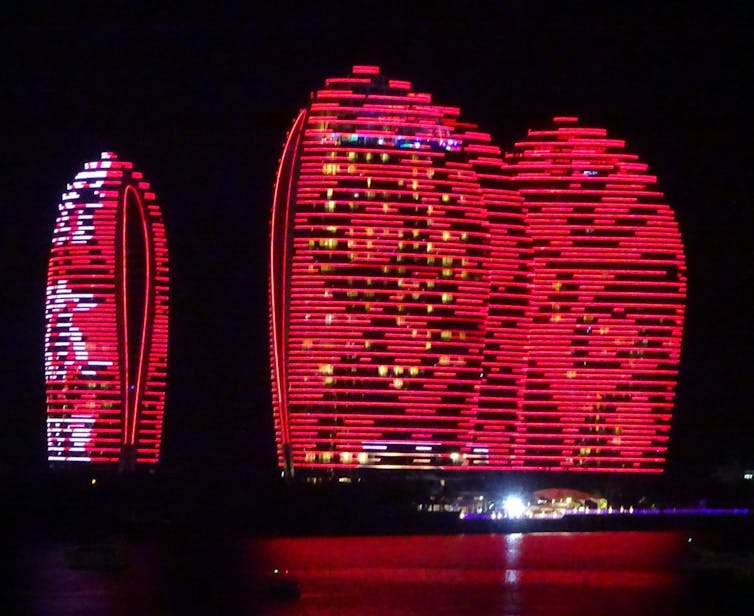Environment & Nature
New islands are being built at sea – but they won’t help millions made homeless by sea-level rise

FILE: The Palm Jumeirah Dubai aerial view on 5 January 2013. (Photo By Richard Schneider from Los Angeles – Dubai Wingsuit Flying TripUploaded by FAEP/Wikimedia Commons, CC BY 2.0)
Dubai’s famous Palm Jumeirah is not the only man-made island to have emerged from the sea this century. Over the past 20 years, many islands have been built to accommodate both tourists and well-heeled residents – especially in the Arabian Gulf states and China.
In an era of sea-level rise and increased storm activity, new islands may seem a risky venture. Yet the desire for a sea view and to put blue water between yourself and the noise, traffic and crime of the mainland is keeping the market buoyant.
Residential artificial islands cater for the rich and have serious environmental consequences. But they ride high on big promises. How else to explain the continuing expansion of Eko Atlantic, a complex of islands sprouting off coastal Lagos in Nigeria?
Construction firms broke ground on Eko Atlantic’s boulevards and high-rise apartments in 2009. The city government has recently announced five more artificial islands “to open up the city”, and claims that the new islands generate and attract wealth and have already created “30,000 direct new jobs”, mostly in construction and maintenance.
The fashion for island-building shows no signs of abating. But instead of an answer to the desperate need for new housing among people who are set to be displaced by rising seas, new islands are offering yet another distraction for the wealthy.
How to build an island
As research for my book The Age of Islands, I visited all sorts of new enclaves that have been reclaimed from the sea. I was amazed at how quickly they can be built. In shallow water, creating an island is not technically complex: usually, the sea bed across a wide area is hoovered up and ground down, then sprayed and pummelled into a stable base.

Alastair Bonnett
In Lagos, the Gulf states and other island-building hotspots like the shores of the Chinese island province of Hainan, developers know their creations must be defended from the sea. Nigeria has the Great Wall of Lagos, a sea barrier containing about 100,000 concrete blocks and rising nine metres above the sea, to protect Eko Atlantic. More modest structures are favoured elsewhere, usually in the form of artificial reefs that are dragged and dropped into place, creating a shield against surging seas.
Will any of this be enough? Such barriers provide enough protection long enough to make island-building an economic proposition. But this calculation misses something important: all these islands rely on the mainland – that’s where they get their energy, water and food. Lagos is a low-lying city and large parts are in danger of flooding. The boulevards of Eko Atlantic won’t look so chic if they are marooned.
Critics of new islands point to the havoc they cause to coastal and river systems, changing patterns of sediment deposition and erosion and creating silty, warm lagoons that turn living marine environments into dead zones.
This is one of the reasons the Chinese government intervened to halt island-building around Hainan. From its shores you can see 11 projects, some in full swing, most paused.

Alastair Bonnett
The world’s biggest and most spectacular new island, Ocean Flower, is found here. It is shaped like a lotus with scrolling leaves and is already crowded with apartment blocks and outlandish architecture, including European-style castles, grandiose hotels and amusement parks. The plan was to have 28 museums, 58 hotels and the world’s largest conference centre.
Even in the hyperbolic world of island building, it sounds extreme. The developer, Evergrande, is now in financial trouble and 39 residential towers on Ocean Flower have been deemed to have flouted environmental and planning regulations and ordered to be demolished.
Boom-and-bust cycles would appear to plague new islands. But these tales shouldn’t mislead us into thinking this is an ailing industry. The financial incentives remain enormous and island makers are an adaptive breed.

Alastair Bonnett
Floating for a few
Floating islands have come to the fore recently: anchored platforms whose construction does not involve scraping away the seabed, making them less disruptive to the marine environment.
Plans for floating cities keep bubbling up. One prospect, Green Float, led by the Japanese company Shimz, would be a floating Pacific city designed to float on the equator “just like a lily pad” and house 40,000 people.
Building on the high seas will always be challenging, so it’s no surprise that ventures closer to shore, such as the Floating City in the Maldives, have been the first to materialise. Floating City is slated as a 500-acre development with 5,000 low-rise homes for 20,000 people arranged in a coral-like scatter of closely connected islets. The first islands have already been towed into place.
The Dutch architect of the scheme, Koen Olthuis, hopes that the Floating City will not be the preserve of the rich (unlike the others I’ve mentioned). His vision is of ordinary Maldivians, having lost homes and livelihoods to rising seas, finding a safe anchorage in the Floating City.
But from what I’ve seen, the world of artificial islands caters to the few not the many. Island-building is led by private developers, not environmentalists – or even states. Foreigners are already being induced to buy into Floating City and told this will be their ticket to a Maldivian residence permit. The bond between wealth and island building will not be easily broken.

Don’t have time to read about climate change as much as you’d like?
Get a weekly roundup in your inbox instead. Every Wednesday, The Conversation’s environment editor writes Imagine, a short email that goes a little deeper into just one climate issue. Join the 30,000+ readers who’ve subscribed so far.![]()
Alastair Bonnett, Professor of Geography, Newcastle University
This article is republished from The Conversation under a Creative Commons license. Read the original article.





















